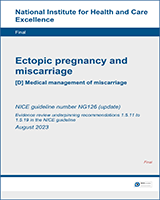From: Medical management of miscarriage

NCBI Bookshelf. A service of the National Library of Medicine, National Institutes of Health.
| Study | Limitations | Applicability | Other comments | Incremental | Uncertainty | ||
|---|---|---|---|---|---|---|---|
| Costs | Effect | Cost effectiveness | |||||
|
Mifepristone and misoprostol versus placebo and misoprostol for resolution of miscarriage in women diagnosed with missed miscarriage: the MifeMiso RCT | Minor limitations | Directly applicable | Economic evaluation alongside RCT | Mifepristone and misoprostol −£182 | 0.0004 QALYs | Mifepristone and misoprostol dominate | Monte Carlo simulation using non-parametric bootstrapping of mean QALYs, and costs suggested there was a greater than 50% probability that Mifepristone and misoprostol was cost-effective |
Modelling was undertaken over a short time horizon and no probabilistic sensitivity analysis was conducted.
Specific costs and disutilities of drug-related adverse events could not be explicitly modelled. Adverse events were captured by modelling treatment-specific withdrawal rates. This may have overestimated the cost effectiveness of maintenance treatment.
The cost-effectiveness model was designed to reflect the management of Crohn’s disease in the Swedish healthcare setting. Although a cost per QALY estimate was reported, it was not based on health-related quality of life values elicited from patients.
From: Medical management of miscarriage

NCBI Bookshelf. A service of the National Library of Medicine, National Institutes of Health.